Enjoying last night’s solar eclipse? How do you know if it could have PERMANENTLY damaged your eyes – while social media users complain their retinas are ‘cooked’
It was called the biggest astronomical event of the decade.
An estimated 32 million people enjoyed one of the most spectacular sights visible from Earth as a solar eclipse swept across North America on Monday.
Videos shared on social media showed people looking at the graying sky to catch a glimpse of the phenomenon that left only the sun’s outer atmosphere visible, briefly turning the outdoors dark during the day.
But without proper precautions, such as special eclipse glasses, spectators could have permanently damaged their eyes, experts warned.
“My eyes are boiling right now and my neck is suspiciously sore,” admitted one X user in Manitoba, Canada.
An estimated 32 million people enjoyed one of the most spectacular sights visible from Earth as a solar eclipse swept across North America on Monday. Above, people view Monday’s solar eclipse from New York’s Times Square on April 8, 2024
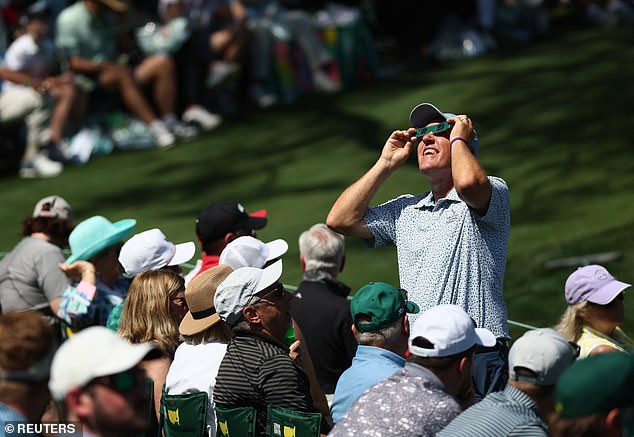
Videos shared on social media showed people looking at the graying sky to catch a glimpse of the phenomenon that left only the sun’s outer atmosphere visible, briefly turning the outdoors dark during the day. In the photo, people use goggles to observe the solar eclipse during the Masters in Augusta, Georgia
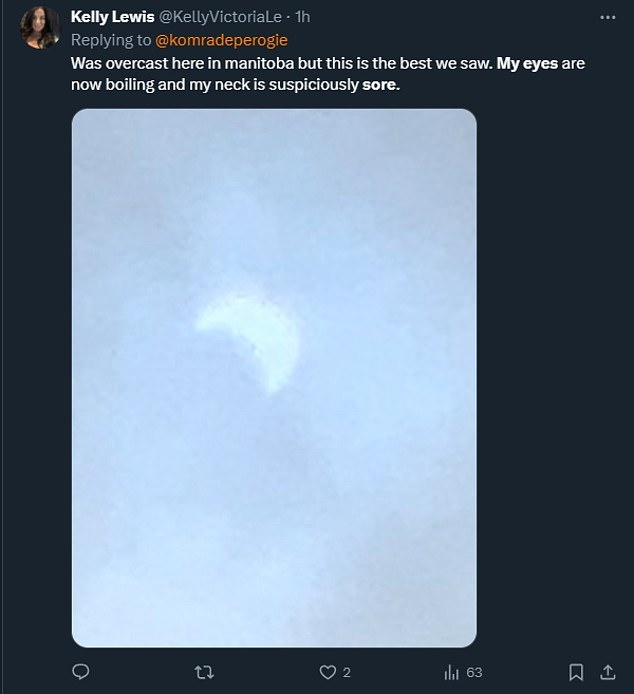
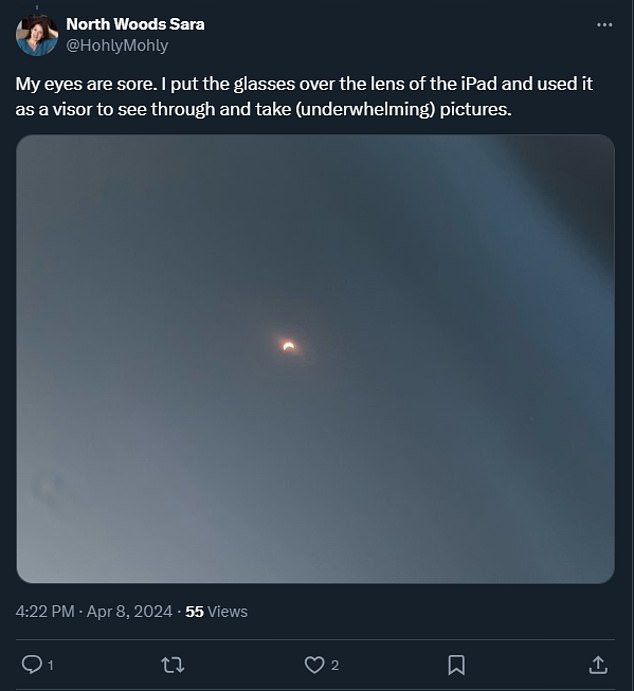

“My eyes are boiling right now and my neck is suspiciously sore,” admitted one X user in Manitoba, Canada. Others complained of ‘sore eyes’, with Google searches showing a steep increase after the event
Others complained of ‘sore eyes’, with Google searches showing a steep increase after the event.
According to NASA, your retina “can become damaged before you know it and by then it may be too late to save your vision.”
“Even looking at the sun for a few seconds during a solar eclipse can temporarily or permanently burn the macula,” Johns Hopkins ophthalmologists Neil Bressler, Jun Kong and Fernando Arévalo said ahead of the eclipse.
‘Once the retinal tissue is destroyed, it cannot regenerate, resulting in permanent loss of central vision.’
The macula is considered one of the most vulnerable parts of the retina and plays a key role in distinguishing details such as written text.
The result of damage to the macula can be eerie: seeing your own face blank in a mirror, or not being able to distinguish words in a newspaper, as if it were blank.
All it takes is about 100 seconds of exposure from solar radiation to cause damage to a person’s retina, although times will vary based on the sun’s intensity, which can vary depending on time of day and geography , and the pre-existing condition of one’s eyes. .
The American Academy of Ophthalmology (AAO) recommends that concerned individuals watch for “visual symptoms within four to six hours” or even the day after the eclipse.
Some may also notice signs after 12 hours.
Symptoms of injury usually include headache, blurred vision, a ‘blind spot’ in one or both eyes, eye sensitivity or visual distortions.
These distortions can be particularly unusual, making objects appear smaller than they really are or causing funny twists or distortions in your central vision.
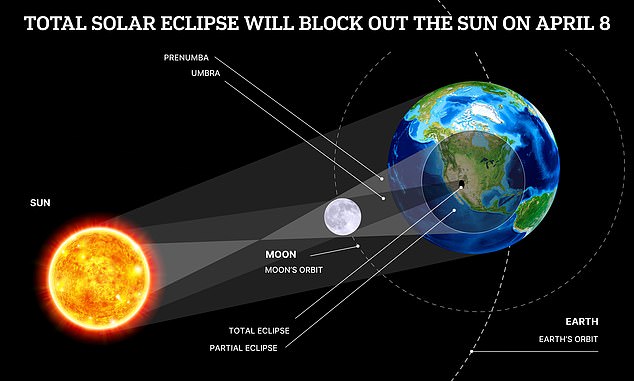
A total solar eclipse occurs when the moon passes between the sun and Earth, completely blocking the sun’s surface. This illustration shows the moon’s shadow moving across Earth on April 8
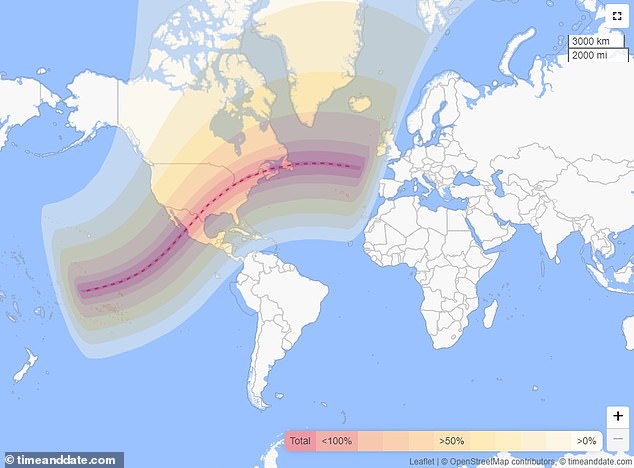
April 8: This color-coded map shows the path of totality as a dotted line in deep pink. It is here where the entire sun was blocked by the moon. Further along are areas where a partial solar eclipse occurred. Shown here is the percentage of sun blocked in these color-coded areas
Fortunately, they can improve over time.
“Many people recover after three to six months, but some will suffer from permanent vision loss, in the form of a small blind spot and distortion,” the AAO said.
However, roughly half of those diagnosed with eclipse blindness will fully recover their vision after six months, says Dr. Ralph Chou, associate professor of optometry at the University of Waterloo.
“At the end of the day you just have to wait and that’s the really unfortunate thing about it,” he added.
“The average person who has been injured will have to wait six to 12 months before knowing what their final status will be.”
Dubbed the “Great American Eclipse,” Monday was the first total solar eclipse visible anywhere in the world since December 2021, and the first from the US since August 2017.
A total solar eclipse occurs when the moon and sun are perfectly aligned and the moon is close enough to us to cover the entire sun from our perspective.
However, cloudy skies prevented spectators in Britain from seeing a partial solar eclipse, in which a small part of the sun was covered by the moon.
It is unlikely that many across the country would have seen the historic event if it had been obvious.
Simon Partridge, a forecaster at the Met Office, said: ‘Chances are that most of England and Wales probably wouldn’t have seen it anyway.’
He added that the eclipse outside north-west Scotland would have been ‘very, very small and probably not really noticeable’ even if clouds had not obscured it.
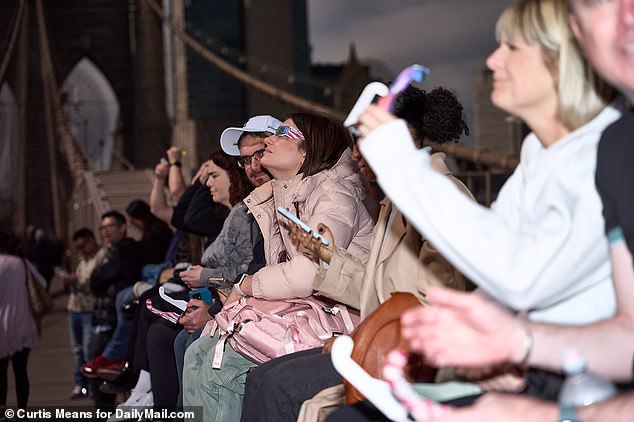
Dubbed the “Great American Eclipse,” Monday marked the first total solar eclipse visible anywhere in the world since December 2021, and the first from the U.S. since August 2017. In the photo, viewers went from the eclipse to the Brooklyn Bridge in New York to watch the solar eclipse. city descends into darkness
In 1999, there were fourteen reports of damaged eyes after a solar eclipse in Britain.
And in 2017, a New York woman suffered blurred vision and permanent dark spots after staring directly into the solar eclipse.
Nia Payne, 26, told doctors that during the eclipse she first looked at the sun for six seconds, then borrowed a pair of glasses she thought were eclipse glasses and looked at the sun for another 15 to 20 seconds.
But six weeks later she still saw dark spots in her left eye.
‘It’s humiliating. People will assume I was just one of those people staring blankly at the sun or not checking out the person with the glasses,” Ms. Payne told CNN at the time.
‘It’s something I have to live with for the rest of my life. But it could be a lot worse, and I’m trying to count my blessings.”
Doctors diagnosed her with a rare case of acute solar retinopathy, which occurs when the eye’s retina is severely damaged by looking directly at the sun.
Experts recommend contacting an optician as soon as the viewer suspects that he or she is suffering from solar retinopathy or eclipse blindness.
The last total solar eclipse visible from Britain occurred in 1999, and there won’t be another solar eclipse until 2090.
